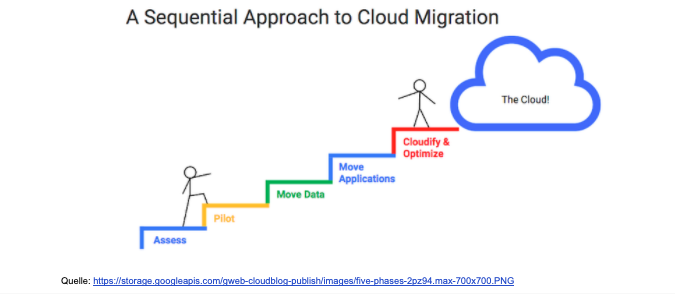In today’s rapidly evolving digital landscape, businesses are continually seeking ways to enhance their agility, reduce costs, and improve scalability. Cloud computing has emerged as a powerful solution, enabling organizations to achieve these goals and more. Cloud migration, the process of moving applications and data from on-premises infrastructure to cloud environments, has become a pivotal step in this journey.
Cloud migration can be a game-changer for your organization, but it’s not a one-size-fits-all solution. To successfully navigate this transition, you must have a well-defined strategy tailored to your specific needs and goals. In this blog post, we’ll explore various cloud migration strategies, helping you make informed decisions to ensure a smooth and successful migration.
Understanding Cloud Migration
Before diving into the strategies, it’s essential to understand the fundamental concepts of cloud migration. Cloud migration involves transferring your applications, data, and workloads from on-premises data centers or other cloud providers to a cloud-based infrastructure. This move offers several advantages, including cost savings, improved scalability, and enhanced security. However, it’s a complex process that requires careful planning and execution.
Successful cloud migration is not just about relocating your applications; it’s about optimizing them for the cloud environment to leverage its full potential. It also involves ensuring minimal downtime and data loss during the transition. To achieve these goals, organizations typically employ one or more of the following cloud migration strategies.
- Lift-and-Shift Migration
The lift-and-shift migration strategy, also known as rehosting, is the most straightforward approach to cloud migration. It involves moving your applications and data to the cloud without making significant modifications to their architecture. In essence, you’re lifting your existing infrastructure and shifting it to the cloud.
This strategy is ideal for organizations that want to quickly migrate to the cloud while minimizing disruption to their operations. It’s often used for legacy applications that are not cloud-native and may not take full advantage of cloud services. While it offers a fast and cost-effective way to move to the cloud, it may not fully optimize your resources or cost savings.
- Replatforming Migration
Replatforming, also known as lift-and-tweak, involves making minimal adjustments to your applications to better align them with cloud services. Unlike the lift-and-shift strategy, which focuses on a direct migration, replatforming aims to take advantage of some cloud-native features without completely rewriting the application code.
This strategy strikes a balance between speed and optimization. It allows you to retain most of your existing codebase while benefiting from certain cloud advantages like scalability and high availability. Replatforming is a good choice if you have applications that can benefit from cloud enhancements without undergoing a full rewrite.
- Refactoring Migration
Refactoring, also known as rearchitecting, represents a more significant transformation of your applications. In this strategy, you modify or redesign your applications to take full advantage of cloud-native services and capabilities. This often involves breaking down monolithic applications into microservices or containers and leveraging platform-as-a-service (PaaS) offerings.
While refactoring can be time-consuming and resource-intensive, it offers the most significant benefits in terms of cost optimization, scalability, and agility. It allows your organization to embrace modern development practices and take full advantage of cloud innovation. This strategy is ideal if you have a long-term vision for your applications and want to position them for future growth.
- Repurchasing Migration
The repurchasing migration strategy, also known as retiring, involves replacing existing applications with cloud-based alternatives. Instead of migrating your legacy applications, you choose to adopt cloud-native software solutions that meet your requirements.
This strategy can lead to substantial cost savings and efficiency improvements, especially when transitioning from on-premises software licenses to subscription-based cloud services. However, it requires careful evaluation of available cloud offerings and may entail changes to your existing business processes.
Key Considerations for Cloud Migration
Regardless of the migration strategy you choose, there are some key considerations that apply to all cloud migrations:
Security: Ensure robust security measures are in place to protect your data and applications in the cloud. Implement encryption, access controls, and monitoring to safeguard your assets.
Compliance: Be aware of regulatory requirements and compliance standards that apply to your industry. Ensure that your cloud environment adheres to these standards.
Cost Management: Monitor and manage your cloud costs diligently. Implement cost optimization strategies to avoid unexpected expenses.
Performance: Continuously monitor the performance of your applications in the cloud and make necessary adjustments to ensure optimal performance.
Data Management: Develop a data management strategy that includes backup, recovery, and data governance practices to protect your data assets.
Conclusion
Cloud migration is a transformative journey that can enhance your organization’s agility, scalability, and cost-efficiency. Choosing the right migration strategy is crucial to achieving success in this endeavor. Whether you opt for lift-and-shift, replatforming, refactoring, or repurchasing, each strategy has its unique benefits and challenges.
Ultimately, the success of your cloud migration depends on careful planning, execution, and ongoing management. It’s essential to work closely with experienced cloud professionals and leverage the tools and resources provided by cloud service providers. With the right strategy and a commitment to continuous improvement, your organization can unlock the full potential of the cloud and thrive in the digital age.



